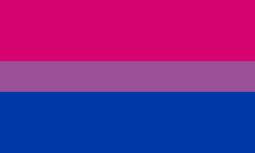
Back علم فخر المزدوجين Arabic Bandera del arguyu bisexual AST Флаг на бисексуалната общност Bulgarian উভকামী আত্মাভিমান পতাকা Bengali/Bangla Banniel an divrevelezh Breton Bandera de l'orgull bisexual Catalan Bisexuální vlajka Czech Flagge der Bisexuellen German Σημαία Υπερηφάνειας Αμφιφυλοφιλίας Greek Bandera del orgullo bisexual Spanish
 | |
| Use | Symbol of the bisexual community |
|---|---|
| Proportion | 3:5 |
| Adopted | 1998 |
| Design | Three solid horizontal bars: two fifths pink, one fifth purple, and two fifths blue. |
| Designed by | Michael Page |
| Part of the LGBTQ series |
| LGBTQ symbols |
|---|
| Symbols |
| Pride flags |

| Part of a series on |
| Bisexuality topics |
|---|
| Sexual identities |
| Studies |
| Attitudes, slang and discrimination |
| Community and literature |
| Lists |
| See also |
|
|

The bisexual flag, also called the bisexual pride flag, is a pride flag representing bisexuality, bisexual individuals and the bisexual community. According to Michael Page, the activist who created the flag based on a color palette designed by Liz Nania,[1][2] the pink stripe represents attraction to the same sex, while the blue stripe represents attraction to the opposite sex. The purple stripe, the resulting "overlap" of the blue and pink stripes, represents attraction to both sexes.[1]
Page designed the flag to increase the visibility of bisexuals among society as a whole and within the LGBT community. He aimed to give the bisexual community a symbol that is comparable to the rainbow flag for the greater LGBT community. The first bisexual pride flag was unveiled at the BiCafe's first anniversary party[3] on December 5, 1998.[4]
- ^ a b "History, Bi Activism, Free Graphics". BiFlag.com. December 5, 1998. Archived from the original on August 1, 2001. Retrieved April 20, 2020.
- ^ "Biangles, bisexual symbol, bi colors, bi history — Liz Nania". Liz Nania. Retrieved June 26, 2022.
- ^ Young, Randy (June 6, 2015). "BiPride Flag". Flagspot. Flags of the World. Retrieved October 24, 2015.
- ^ "Counseling and Wellness Services - Safezone Symbols". October 20, 2013. Archived from the original on October 20, 2013. Retrieved December 28, 2021.